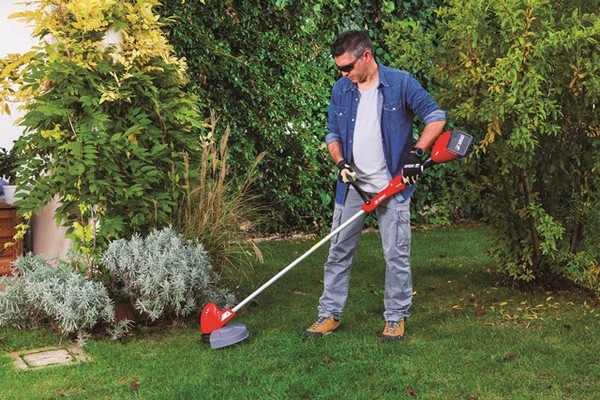
The rise of batteries in machinery for gardening
The battery-operated machinery and equipment are increasingly in demand in gardening and green care. From lawnmowers to blowers, from chainsaws to brushcutters, the range of electrical machinery is increasingly wider and efficient, thanks to the use of technologies as the lithium ion which is much more performing than the systems used in the past. There are also considerable benefits in terms of user-friendliness, operator comfort and above all environmental impact. The hypothesis of introducing cobalt systems is debatable because they depend on a Congolese monopoly in the supply of the raw material and by a Chinese monopoly in its refining
Environmental sustainability is the basis for economic and social development of the 21st century. This involves phasing out fossil fuels and greater use of less polluting sources, or zero emission, such as electricity. The rise of the use of increasingly powerful and safe lithium batteries fits in this perspective. Their use in the green sector has expanded significantly over the recent years, especially for the machinery carried by the operator such as blowers, brush cutters, chainsaws, hedge trimmers ... but also for robotic lawnmowers and lawnmowers with the driver on the ground and on board. This machinery, provide similar operational performance compared to the same fuel-powered engine models.
Lithium-ion batteries
At present, except for rare exceptions, on the market, there are lithium-ion batteries. This is because lithium is a high energy density metal with low molecular weight and a consequent high ratio: electric potential/weight. Other metals are used in combination with lithium. Most frequent combinations are lithium-cobalt oxide, lithium-nickel-manganese-cobalt, lithium-manganese oxide.
The lithium accumulators, unlike the traditional ones, do not contain heavy metals and are 80% recyclable, thus allowing to reduce both natural resource extraction and their disposal. They have a long service life of 600-900 cycles (one cycle corresponds to a battery discharge plus a recharge). If the service life is, for example, 750 cycles, it means that after this time the battery will continue to work, but with progressively lesser performance until complete exhaustion, which will be followed their recovery by recycling. Depending on their characteristics, battery recharge time varies from less than 1 hour to 4-5 hours, and so does the duration after each recharging, which is conditioned by the workload to which they are subjected. Normally the recharging time lasts between 45 minutes and a few hours. The charging system is provided by the battery manufacturers. Thanks to their low weight, the batteries can be inserted directly into the machinery or, to increase their autonomy, they can be carried like a backpack by the operator. More precisely, the weight of a battery mounted on the hand-held tool, be it a blower, a brushcutter, or other, is less than 1 kg, while for the best performing batteries carried as a backpack it is possible to reach 5-6 kg. An important feature is that both the batteries and the chargers are interchangeable, meaning that the same battery can power different tools of the same range (for example blower and brushcutter), and the same charger can be used for batteries mounted on different tools. Two other important features are due to the fact that the batteries: have no “memory” and this means that they can be charged regardless of the download percentage; the loss of charge during inactivity does not exceed the percentage of 2% -3% per month. This allows to store them without having to top them up at the time of use.
Battery-powered machinery and tools
There are many reasons why, especially for garden maintenance, professionals increasingly use tools and battery-powered machinery. First of all the light weight of the machines carried by the operator that makes them more manageable and less tiring in use, causing less stress to the limbs, thus reducing the risk of injuries and of musculoskeletal diseases. The greater comfort in use is also due to the low sound level which, for these tools, generally does not exceed 80-90 dB and which, as such, is less impactful when operating in places of public use.
Other reasons behind the choice are: quick and trouble-free starting (just press a button), reduced maintenance, lower operating costs, and longer life compared to the same models with an endothermic engine. These advantages offset the higher initial investment. Finally, a very important reason for environmental sustainability is the non-production of direct emissions of CO2 and other greenhouse gases. It would be best to be able to recharge the batteries with a non-polluting source such the photovoltaic panels.
Some examples of battery-powered equipment and machinery
Chainsaws - There are several manufacturers and battery-powered chainsaws. The power ranges between 36 V-3 Ah and 56 V-5 Ah, for a weight ranging from 2.0 to 4.5 kg, while the length of the chain guide ranges from 30 to 40 cm. The chain rotation speed is of the order of 20 m/s and the performances and safety systems (automatic blade stop, etc.), are similar to those of the endothermic engine models. The autonomy of the battery mounted on the chainsaw is around 30 minutes. Of course, regardless of the propulsion system, the sharpening of the chain must always be carried out with care.
Hedge trimmers - There are many models in this category as well. The powers range from 36 V-1.6 Ah to 56 V-5 Ah, for a weight between 3.0 and 5.0 kg, while the length of the blade goes from 50 to 70 cm, with a gauge between the teeth of 2.0-3.5 cm. Some models are equipped with a cutting frequency variator that ranges between 2000 and 6000 cuts per minute. The models that are mounted on a telescopic arm generally have a blade of less than 60 cm.
Hand Blowers - They are used for cleaning lawns, roads, paths and other places, such as stadium stands after matches. The material to be collected is the most varied depending on the conditions of use, from leaves fallen to the ground to paper, from jars to plastic bags, etc. The minimum weight without battery is about 2.5 kg and this makes them very manageable and particularly suitable for cleaning not easily accessible areas. The air flow rate can be varied and reaches the maximum value of 900-1000 m3/h, with a speed ranging from 50 to 200 km/h. The vibration level is reduced and also the sound level does not exceed 80 dB, compared to the 120 dB of an endothermic motor blower.
Brushcutters - Essential for the maintenance of parks, gardens, and roadsides, they are made in different versions. Usually, they are multifunctional, as they can be fitted with different wire or blade cutting heads. The powers range from 200 W to 2.0 kW, for a weight between 2.0 and 5.0 kg, while the working width is around 35-40 cm. Vibrations are small (less than 1.25 m/s2) and it is the sound level (less than 85 dB). For use in urban environments versions are made without protections, thanks to the heads with counter-rotating, between them, double blade. The idle speed is around 6000 rpm and is variable to adapt to the working conditions, with the possibility of reversing the rotation direction to facilitate the cleaning of the cutting head.
Electric scissors - They reduce the effort of pruning work. They are light as their weight ranges between 600 grams and 1.0 kg. There are models with interchangeable blades, with a maximum cutting diameter from 30 to 45 mm, and with a maximum blade opening from 55 to 70 mm, adjustable according to the branch diameter.
Lawnmower with the driver on the ground - They are increasingly popular thanks to the cutting performance similar to that of the lawnmowers with an endothermic engine. They can be moved manually or self-propelled. The engine power ranges from minimum values of 250 W to over 1 kW. The working width goes between a minimum of 30-35 cm and a maximum of 60 cm, while the cutting height is adjustable between 25 and 70 mm. They can perform both mulching cutting and cut with collection in the basket (capacity from 35 to 70 liters). The self-propelled models compared to the version with the endodermal motor have an hourly operating cost 7-10 times lower (staff excluded).
Lawnmower with the driver on board - Some manufacturers have put on the market battery-powered machinery with horizontal blade cutting units, and hybrid machines, in the version with helical blades for golf courses. Battery-powered electric lawn mowers have a working width of 80-85 cm and a maximum power of 5.2 kW, with a cutting height going between 25 and 70 mm. The hybrid mowers version both for greens and fairways have interesting constructive solutions allowing a significant fuel saving. The hydraulic circuit of the cutting cylinders has been eliminated and replaced with an alternator that keeps the speed at the desired speed, thus allowing the engine to run at a lower speed. Thus, with specific reference to the three-cylinder model for greens, the engine instead of operating at a speed of 3000 rpm, works at a speed of 2250 rpm allowing an hourly fuel saving of 25-30%.
Robotic lawnmowers - The use of these robots is growing both in gardens and in sports fields. The working widths range from 20 to over 100 cm, allowing turf surfaces to be treated from 500 to 20000 m² and to overcome slopes of 45%. The cutting apparatus is with blades (from 1 to 3) and the cutting height ranges from 20 to 60 mm. Once the perimeter of the turf is delimited, the robot moves inside the surface and, thanks to the sensors it is equipped with, it avoids any obstacles in its path (trees, boulders, flower beds, etc.). The batteries are recharged automatically, with the possibility of transmitting any operational problems to the user via SMS. The duration is normally between 60 and 90 minutes. On some models, the installation of a GPS system makes a map of the garden and the paths to follow.
Future prospects
Mobility on the road is increasingly moving towards hybrid and all-electric machinery. The main car manufacturers are committed in this direction even though it is difficult to predict the timing of this change.
The automotive sector evolution has also led to the study and search for always more efficient batteries. Among the proposed solutions there are the solid-state batteries. It is the replacement of the electrolyte in the liquid state with a solid state, always in lithium. In this way the energy density increases and consequently, all things being equal, also the autonomy. Furthermore, the solid-state electrolyte eliminates the overheating of the battery and, therefore, it also reduces the risk of its explosion. In addition to being safer, these solid electrolyte batteries have a longer life and require shorter charging times.
Another aim of the research is the replacement of the cobalt which, in the batteries of a car, can reach a weight of 14-15 kg. A cause for concern, despite the increasingly high cost of cobalt, is the fact that 65% of the world total is located in the Democratic Republic of the Congo. Besides the geopolitical problems of this area, the acquisition by China of the refining monopoly of this metal is a substance of concern. Hence the search for lithium batteries without cobalt, replaced by other metals such as nickel, ferro-phosphate and manganese. In these researches, we also make use of Artificial Intelligence in order to find, among the many possible combinations, those that can represent a valid substitute to the metals currently employed.








